CSC News
Locking Down Cloud Computing
Source – Results: Research and Graduate Studies at North Carolina State University
Volume X, Number 1, Spring 2010
 Wireless sensor networks increase flexibility in military and industrial settings, but they also raise the potential for nefarious elements to wreak havoc. Even Dr. Peng Ning, a good-natured associate professor of computer science at NC State not given to paranoia, sees threats everywhere. “Someone could pick up a sensor and reprogram it to send false signals. Terrorists could use a powerful computer to overwhelm a network of sensors,” he says. “Network security is critical.”
Wireless sensor networks increase flexibility in military and industrial settings, but they also raise the potential for nefarious elements to wreak havoc. Even Dr. Peng Ning, a good-natured associate professor of computer science at NC State not given to paranoia, sees threats everywhere. “Someone could pick up a sensor and reprogram it to send false signals. Terrorists could use a powerful computer to overwhelm a network of sensors,” he says. “Network security is critical.”
Wireless sensors are deployed by the military for battlefield surveillance and by a growing number of industries to monitor machinery vibration, fluid flow, and other systems. The minicomputers are smaller than a tin of Altoids, run on batteries, and use radio transceivers. When they’re deployed throughout a factory or military front, they relay messages to and from their closest neighbors, with one end of the chain communicating with a central computer. “The sensors notify people when something in the manufacturing environment has changed, so they can repair it quickly,” Ning says. “The sensors could save lives by keeping troops aware of enemy activities.”
But here’s the rub: The sensors’ small size and limited memory make them easy targets for terrorists and hackers, Ning says, so his research team has developed a suite of security algorithms and open-source software packages. Although these packages use advanced cryptography to secure a network and provide services securely across it, they include a minimal amount of code to avoid taxing the sensors’ capacity. For example, Ning developed a message-specific puzzle, where certain pieces of data create a pattern, to ensure that only the network operator can program the sensors.
To expand beyond sensor networks, NC State launched the Secure Open Systems Initiative (SOSI) in 2008 to find ways to secure open-source software and computer systems against malicious attacks. Gathering various computer-security efforts under one umbrella is boosting collaboration and attracting more federal funding for projects, says Ning, who is SOSI’s technical director. Industry collaborators like Red Hat, IBM, and Cisco Systems are attracted by the opportunity to test the security tools SOSI develops.
The initial focus is on virtual cloud computing systems, where data residing on remote servers could be vulnerable to attacks from other users or the system itself. Ning and Drs. Xuxian Jiang and Mladen Vouk recently won a $3 million National Science Foundation grant to develop security solutions for next-generation computing clouds. “Wireless sensor networks are just a small piece,” Ning says. “We hope our work will make all open systems safe for users.”
###
Return To News Homepage